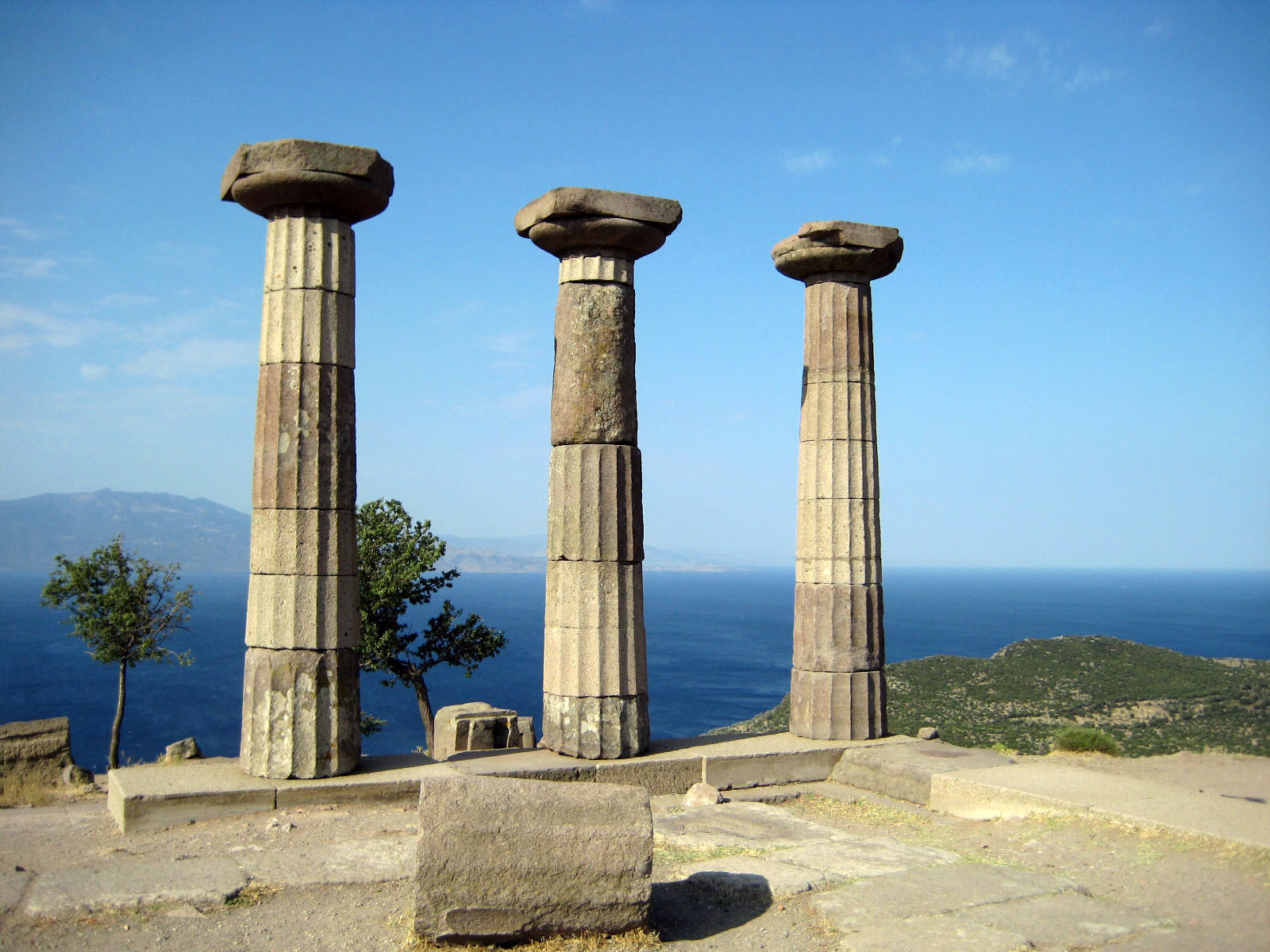
Our map of Turkey makes most of the roads look like super highways; these thick lines in any other country would translate to autostrada, autopista, autoroute or autobahn. In fact, after picking up the car, we entered a very big and fast super road, at least for about 20 kilometers when it dumped us out into a village with traffic worthy of Cairo.
It was 40° C (104° F) and we were glued to the traffic. The supposed 2 hour drive turned into a hard 5 hours of stop and go all the way from Izmir up the Aegean coast. We thought about visiting Troy and Pergamon in the northern Aegean. Nothing really remains at these sites, just a few holes in the ground with markers that tell you were others found something and removed it to a museum in another country. At the site of Troy, the Turkish tourist board commissioned a replica of the famous Trojan horse. Whopee!!
After 5 hrs to get there and then probably another 6 hr drive to get back down the coast near Ephesus, we decided to have a nice one night in Assos and turn around. We can always go to the British museum and the Pergamon Museum in Berlin.
The Biber Everi hotel (House of Peppers) has been open about a year. Lufti Oguzcan, a Turk who lived in London for the past 20 or so years returned home a couple years ago and hand crafted this old stone house into a beautiful hotel. The creativity is a pure joy; a mixture of old stone walls, railroad tie flooring, ancient artifacts from Assos, ottoman style cabinetry, heated bathroom floors and lots of other clever nods. The only problem is it’s way the hell out there in Assos Turkey.
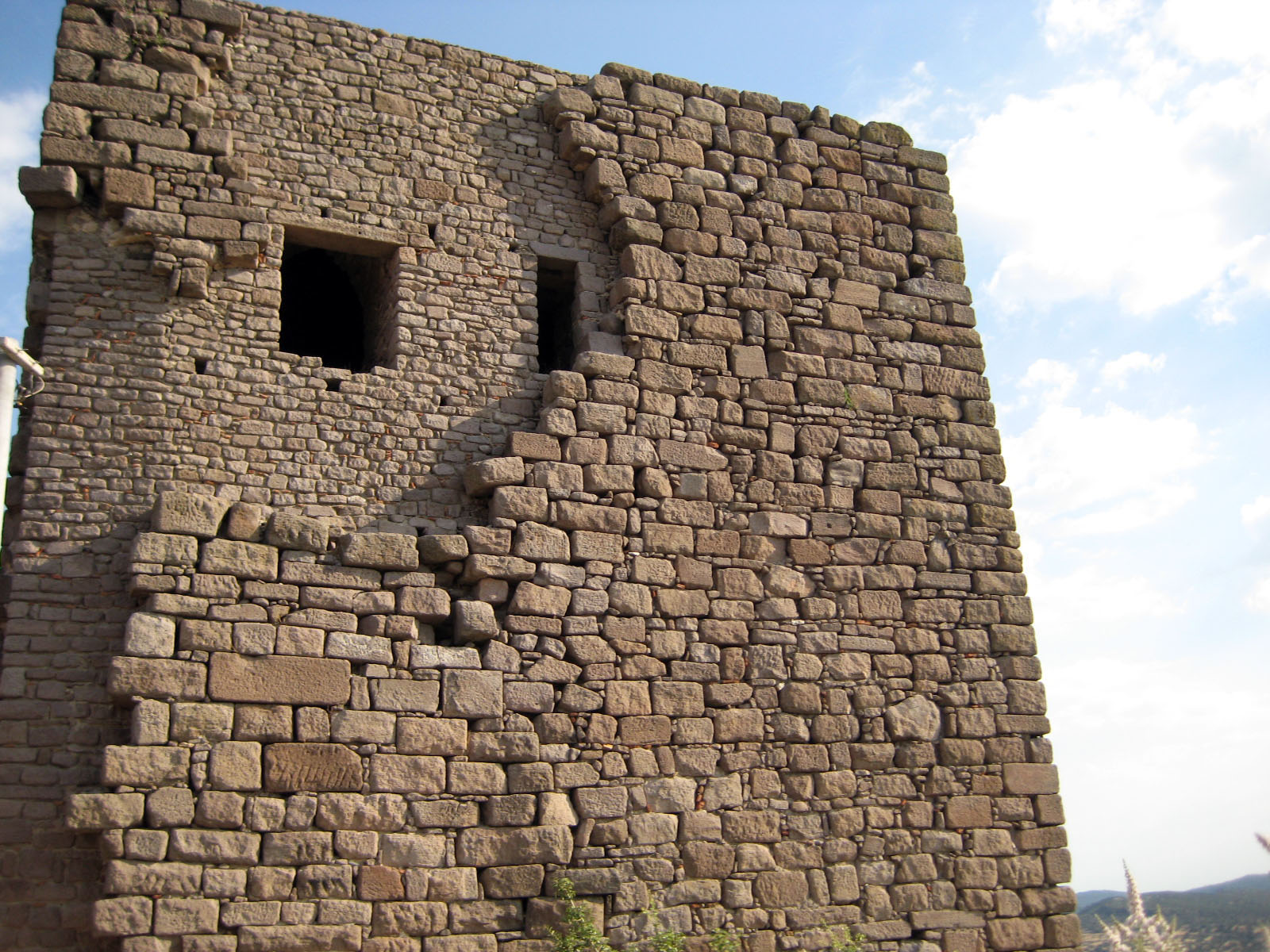 Assos still has old 46’ tall walls that date back to the same time as Ancient Troy and Pergamon, who only have holes in the ground. It actually was a pretty important ancient city for a while when Aristotle and a few of his friends from Plato’s Academy moved here and developed the sciences of Botany and Biology. The view over the Gulf of Edremit to the Greek island of Lesvos is spectacular. Lufti explained to us that this 9 mile stretch between Assos and Lesvos is now heavily guarded by Greek police. In the past few years, Afghanistan refugees made it through Turkey with rubber rafts concealed in their suitcases to cross over to Greece. From there, they attempted to seek political asylum in the UK. It’s all a sad story. First of all, the UK now recognizes the Afghan government and isn’t keen to accept their discontented citizens. The Greek soldiers used to pick them up and deport them back to Afghanistan but now they have orders to shoot holes in the rubber boats. Unfortunately, most Afghans can’t swim. Afghanistan is a landlocked country. A few months ago 11 of them drowned trying to cross the Gulf.
Assos still has old 46’ tall walls that date back to the same time as Ancient Troy and Pergamon, who only have holes in the ground. It actually was a pretty important ancient city for a while when Aristotle and a few of his friends from Plato’s Academy moved here and developed the sciences of Botany and Biology. The view over the Gulf of Edremit to the Greek island of Lesvos is spectacular. Lufti explained to us that this 9 mile stretch between Assos and Lesvos is now heavily guarded by Greek police. In the past few years, Afghanistan refugees made it through Turkey with rubber rafts concealed in their suitcases to cross over to Greece. From there, they attempted to seek political asylum in the UK. It’s all a sad story. First of all, the UK now recognizes the Afghan government and isn’t keen to accept their discontented citizens. The Greek soldiers used to pick them up and deport them back to Afghanistan but now they have orders to shoot holes in the rubber boats. Unfortunately, most Afghans can’t swim. Afghanistan is a landlocked country. A few months ago 11 of them drowned trying to cross the Gulf.
The big attraction in Assos (besides the cooking of Lufti Oguzcan) is the Doric Temple of Athena built in 540BC. It’s a beautiful setting, but all that’s left are three re-assembled columns and the ancient temple platform. The friezes, jewels and other Assos artifacts now reside in Boston, Paris and Istanbul. Lucky of us, the ticket seller at the entrance had a snapshot photo book of the old treasures in their new homes. A few years ago, one of the residents of Assos made a pilgrimage to all the museums to show the other villagers what was taken from them. They’re not great photos, but they do show what used to be there.
The winds over the Gulf are wicked. We tried to take a self photo using the camera’s self timer but the camera blew over. I caught it just in time before it smashed against the rocks. The Greeks call these winds the Meltemi. The Turkish refer to them as the Haydar winds. The Turks and the Greeks don’t agree on much of anything.
We’re growing very fond of Turkish coffee. There is an old Turkish proverb that says, “Coffee should be black as hell, strong as death, and as sweet as love”. It takes a while to make and when it is served, you can almost chew it. They grind the beans into a power and then boil it in the water. It’s been made this way since the 13th century. You have to add a little sugar. But here’s the catch. The Turkish don’t really drink Turkish coffee for breakfast; it’s more of an after dinner treat. The Ottoman Turks introduced the world to coffee.
As we left, Mehmed (the hotel staff) poured a bucket of water onto and behind the car as we left the parking lot. Lufti said it was to guarantee a safe journey; “you will travel like a river without disruption”. We thought it was a charming old tradition but when we were almost killed by a wild Turkish driver cutting into our lane a few hours later we thought, hey, maybe there was something to this. We’ve been pouring water behind the car ever since. We’ve escaped injury three times so far. Turkish drivers are crazy. One car cut us off going about 80 mph and put both cars into an out of control tailspin. When the cars finally did hit, it was just kiss. No damage. The offensive driver got out of his car, put his hand to his heart and bowed, returned to his car and drove away. Gretchen hasn’t taken off her “boncuk” (evil eye) bracelet since we left Istanbul. Any extra protection is welcome on the roads of Turkey.
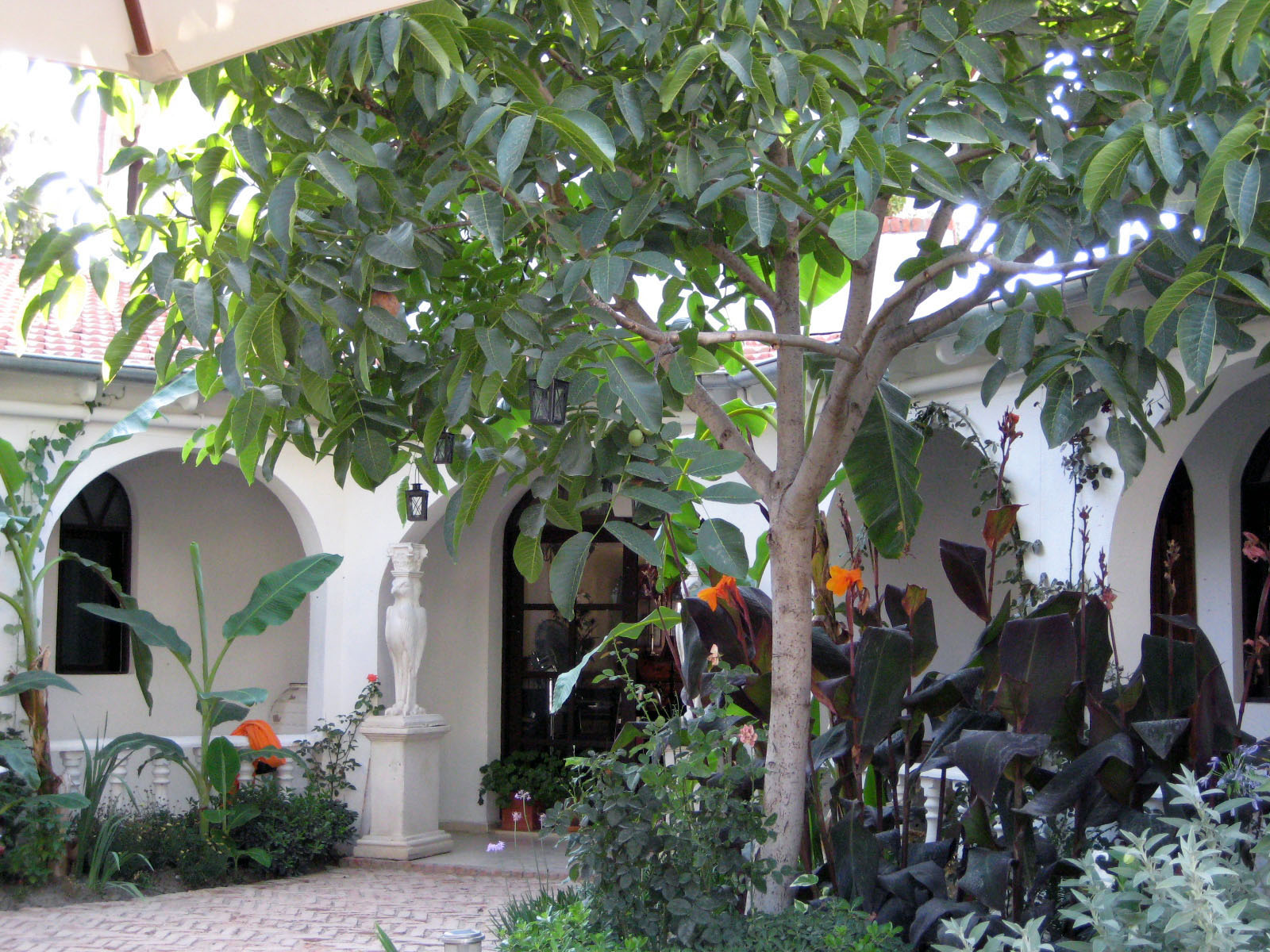 Kirazli, our next destination, is a modest farming village near Selcuk and Ephesus on the southern Aegean Coast. Tractors line the narrow streets; no one uses cars. Tractors are the only conveyance. Hey dad, can I have the keys to the tractor tonight?
Kirazli, our next destination, is a modest farming village near Selcuk and Ephesus on the southern Aegean Coast. Tractors line the narrow streets; no one uses cars. Tractors are the only conveyance. Hey dad, can I have the keys to the tractor tonight?
Stephen and Adrian, the owners of the Muses Hotel are two Brits who gave up their Victorian mansion lifestyle in Wales, packed up their things (very valuable antiques) and moved to Kirazly. They built themselves a colonial retreat that even the Royals would approve of. We might have been a little skeptical when we arrived to this village of blocky stucco houses, poor dusty people and old decaying dogs, but once we opened the front door, we were transported into the proverbial lap of luxury. The hotel has 5 ensuite rooms, each built with respect to the most comfortable accommodation and design. There is a beautiful swimming pool, a garden oasis and one of the best restaurants in all of Turkey. They also just finished a small villa (with private pool) across the street. Adrian, besides designing and building the hotel is an amazing chef. It’s definitely a bit off the beaten path (and very much on the unpaved path), but what a discovery. I think within a few years they’ll probably buy up more of the older farm houses and extend the empire.
On the day we made our visit to the ancient ruins of Ephesus, we hit market day in Selcuk, the largest fruit and vegetable fair we’ve ever seen. The stalls went on for close to a mile, each piled high with fresh tomatoes, cucumbers, eggplant, onions, potatoes, melons, apricots, grapes, dried fruit, nuts, sweets, Turkish delight of all shapes and flavors spices, cheese and bread. Unlike outdoor markets in western European countries that close up around 1pm, this one goes on all day long.
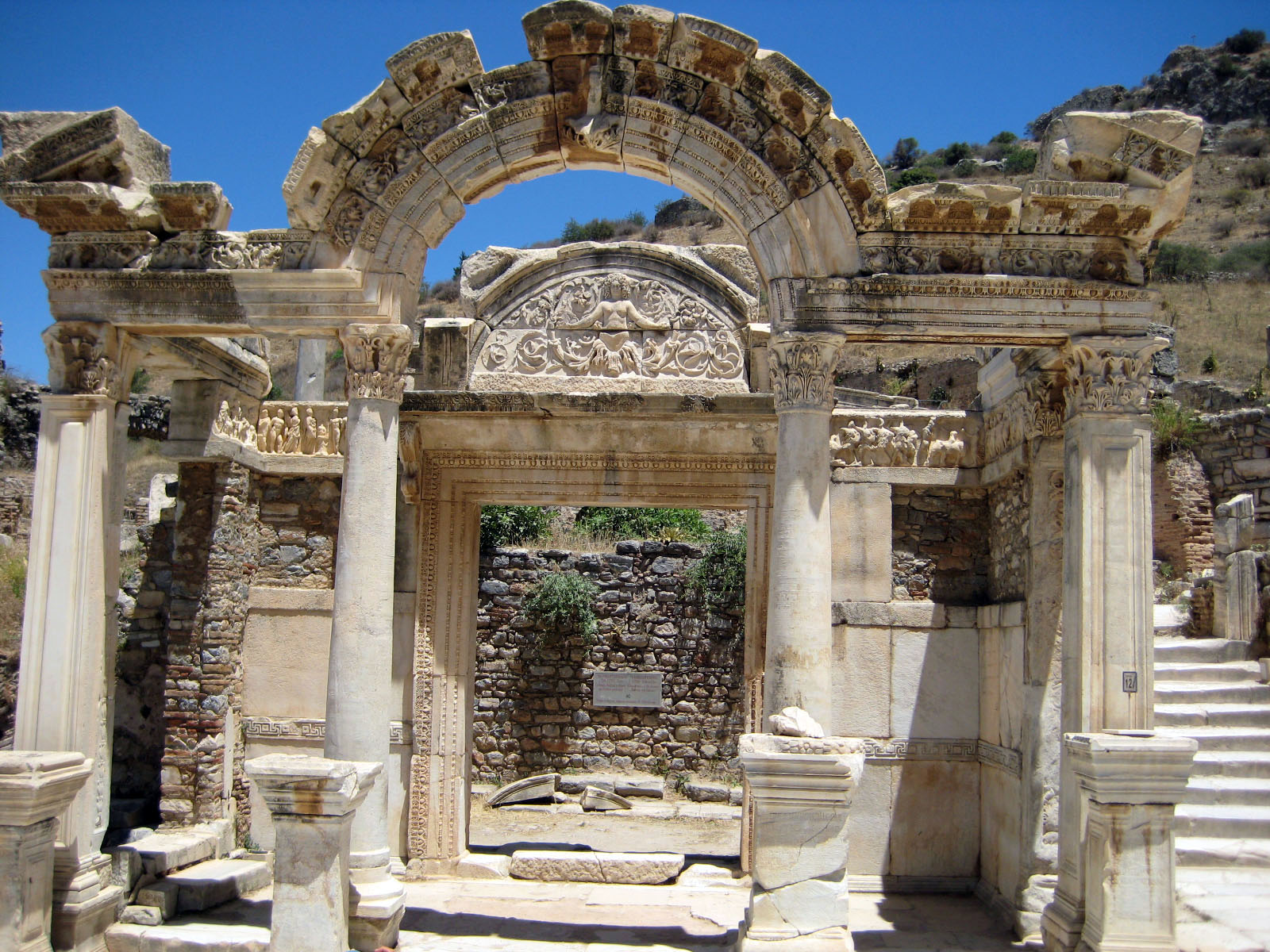 Around 100 AD, Ephesus had a population around 450,000, making it the largest city in Roman Asia. It had one of the most advanced aqueduct systems in the ancient world, providing water to bathhouses and toilets all over the city; yes the toilets in some houses did have plumbing. There ware still ruins of ancient clay pipe sections virtually littering the site. These are very thick and strong water pipes. Lufti up in Assos told us it takes a long time and a very powerful power saw to cut through them.
Around 100 AD, Ephesus had a population around 450,000, making it the largest city in Roman Asia. It had one of the most advanced aqueduct systems in the ancient world, providing water to bathhouses and toilets all over the city; yes the toilets in some houses did have plumbing. There ware still ruins of ancient clay pipe sections virtually littering the site. These are very thick and strong water pipes. Lufti up in Assos told us it takes a long time and a very powerful power saw to cut through them.
For the most part, Ephesus has been reassembled. Earthquakes over the years pulled the city down at least three times. The archeologists have made a fairly reasonable reconstruction but without a city plan, it’s hard to tell how true it is, but it looks good. The mosaics of some of the residences are in surprisingly good condition. The reassembled entrance to the Temple of Hadrian is conveniently next to the brothel.
 The centerpiece of the old city is the Library of Celsus. Back in the 3rd century it held over 12,000 scrolls (volumes).
The centerpiece of the old city is the Library of Celsus. Back in the 3rd century it held over 12,000 scrolls (volumes).
The building faces east so that the reading rooms could make best use of the morning light. Three stories (of the original four story building) were reconstructed in the 1970’s by a German archeological team. It looks great, even though it’s only a re-assembled façade. It’s pretty disappointing when you go through to the rear side.
When the ancient Romans got tired of reading the scrolls, there was an underground tunnel, marked by figures of a woman, a heart, and a price, that led from the library to the nearby brothel.
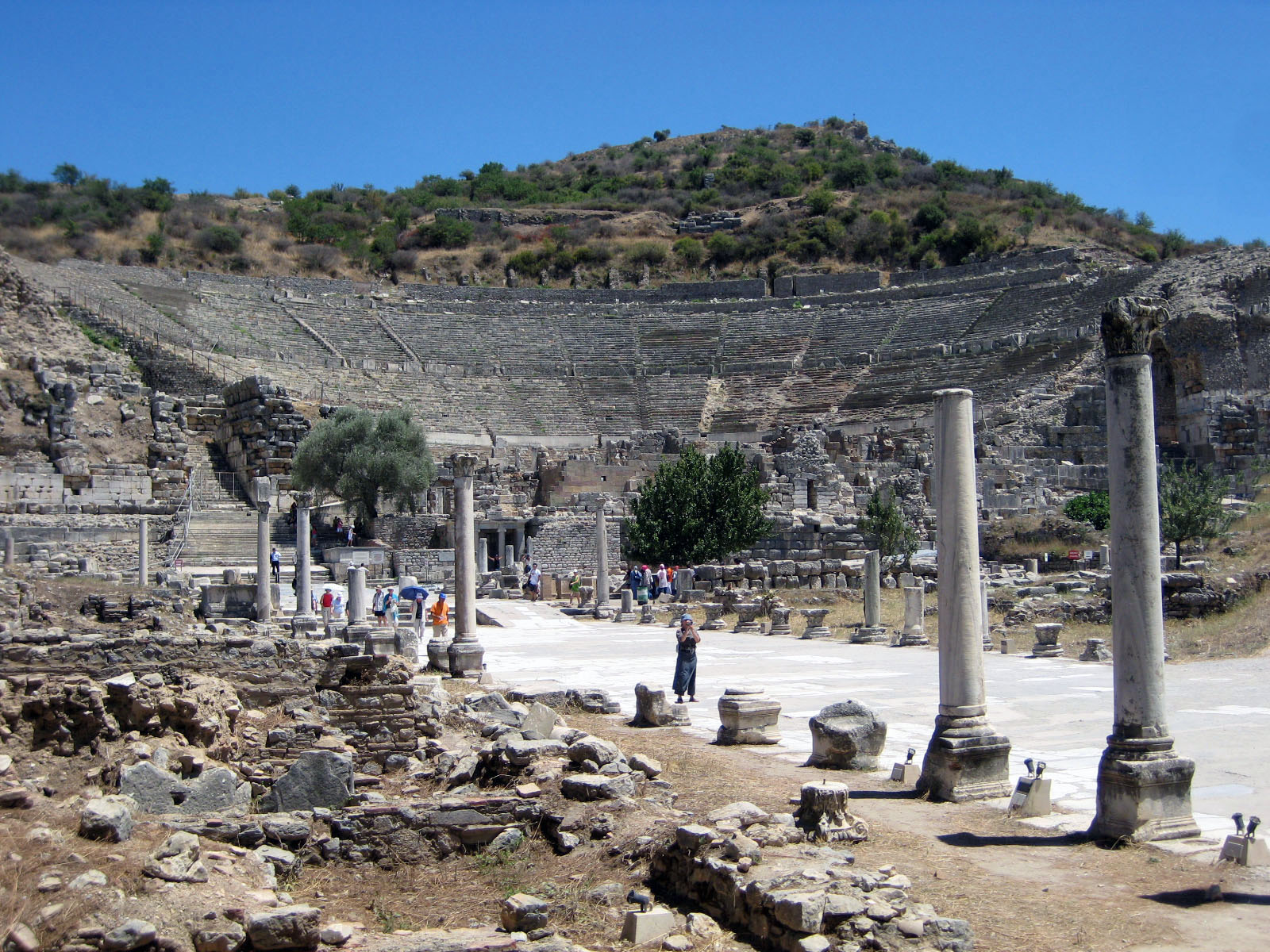 The massive 25,000 capacity theatre, now home to the Ephesus Summer Music Festival, seemed to survive most of the earthquake damage. Performances here ranged from dramatic plays to gladiator fights.
The massive 25,000 capacity theatre, now home to the Ephesus Summer Music Festival, seemed to survive most of the earthquake damage. Performances here ranged from dramatic plays to gladiator fights.
A gladiator graveyard was found in May 2007. Some of the exhumed bones are now on display in the Selcuk archeology museum along with a really good description of how the Gladiator died by showing the wound inflicted into the recovered bone or skull. There are also charts of facts surrounding the life and specialties of a gladiator and the ages of those found in the burial yard. Most gladiators didn’t last more than 5 fights and many of the listed died in their young 20’s. A small number of them did make it into their 60’s. After so many years and so many victories, the survivors would get their freedom and a small home for services rendered in entertaining the masses; a pensioner’s plan for aging gladiators.
Ephesus was also the center of the Cult of Artemis, the hunter (the Romans referred to her as Diana, the brother of Apollo). The Temple of Artemis (or where the temple used to be) is outside of the main park. Archeologists have been excavating the site for hundreds of years. At this point, only one column has been mounted in the area to show where it used to be. Most of this Wonder of the Ancient World is now submerged in a swamp.
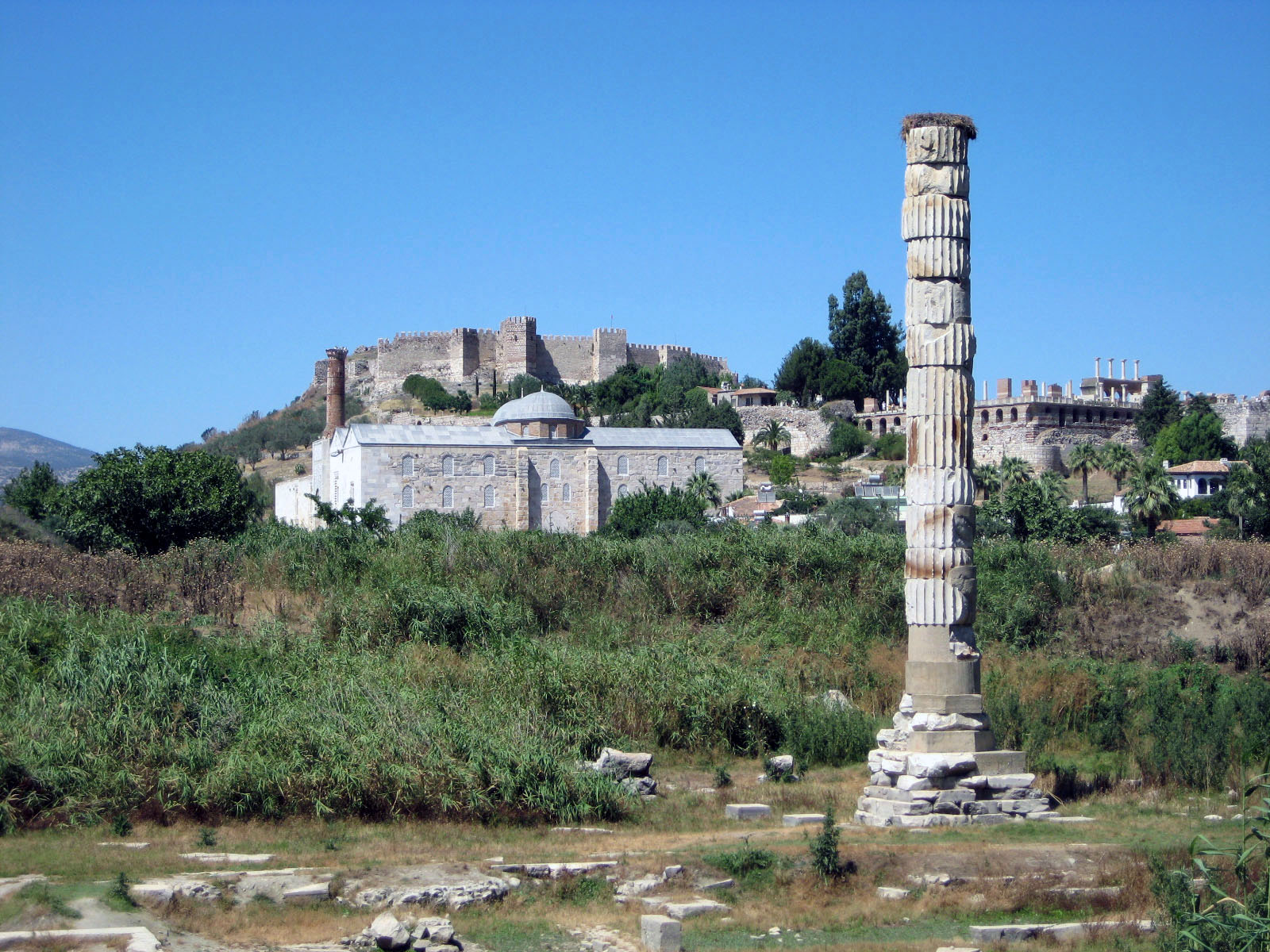 The Temple of Artemis was big; 260’ x 430’ with 60’ tall columns, 127 of them. It was said the interior was filled with golden pillars, four ancient bronze statues of Amazons, silver statuettes, glorious paintings and, of course, the grand statue of Artemis. The entire complex was covered with a wooden roof, which might not have been such a good idea. On the night of July 21st, 356 BC, a man named Herostratus torched the roof and burned the temple to ground in an attempt to immortalize his name. I guess he succeeded.
The Temple of Artemis was big; 260’ x 430’ with 60’ tall columns, 127 of them. It was said the interior was filled with golden pillars, four ancient bronze statues of Amazons, silver statuettes, glorious paintings and, of course, the grand statue of Artemis. The entire complex was covered with a wooden roof, which might not have been such a good idea. On the night of July 21st, 356 BC, a man named Herostratus torched the roof and burned the temple to ground in an attempt to immortalize his name. I guess he succeeded.
On the same night, Alexander the Great was born. The historian Plutarch later wrote that the goddess Artemis was “too busy taking care of the birth of Alexander to send help to her threatened temple”.
The temple was rebuilt 3 times on the site. When St. Paul took up residence in Ephesus in the 1st century AD, he converted many of the city to Christianity, but the cult of Artemis kept him away and protected their temple. It wasn’t destroyed for the second time till the Goths sacked it in 262 AD. But the cult was still strong enough to rebuild it one more time. The last version lasted about 150 years when it was finally shut down by the Christians. Emperor Justinian hauled off most of it for building projects in Constantinopolis. Supposedly a lot of it went into the building of the Hagia Sophia.
No one really visits the Artemis site any more. There’s not much there to see. The tour buses just drive by the entrance and head on over to the big ticket items in the archeological park down the street. In fact, there’s not even an admission charge to get in to see this old Temple site, which is rare in Turkey. They usually find a way to charge for any piece of antiquity.
There are 2 of the 7 ancient wonders in this along this coast. Even if they don’t exist anymore, we’re still determined to see what’s left of them.
 The Seluk museum is approximately 500 meters from the Temple of Artemis. Any artifact that wasn’t hauled off to London, Paris, New York, Istanbul or Berlin is here. There isn’t much but what is here is very good, and it’s a nice cool rest from the sun.
The Seluk museum is approximately 500 meters from the Temple of Artemis. Any artifact that wasn’t hauled off to London, Paris, New York, Istanbul or Berlin is here. There isn’t much but what is here is very good, and it’s a nice cool rest from the sun.
The stars of the collection are the two very exotic statues of Artemis with a lot of booby things hanging off her chest. No one is really sure what the boobies represent. The secret was lost when the cult of Artemis died. Some think they’re breasts. We thought they were eggs. Another theory is that they were testicles because there was a Roman cult who worshiped the goddess Cybele with similar looking statues. The true worshipers of testicle cult of Cybele castrated themselves in her honor. Now that’s devotion. Ouch!!
Other bizarre artifacts in the museum are a couple of statues of the fertility god Priapos with his humongous erection. Not only would he help fertility but he was also used as an “evil eye”, protection from evil. There are also some examples of early Christian graffiti. Crucifixes were carved into the heads of many of the Roman statues including Augustus and his wife Livia.
On the way back to the hotel, we stopped off at what was advertised as the largest Steam Engine train museum in all of Europe. Hey, it was on the way and admission was free if you went into the Ephesus Ceramic shop first.
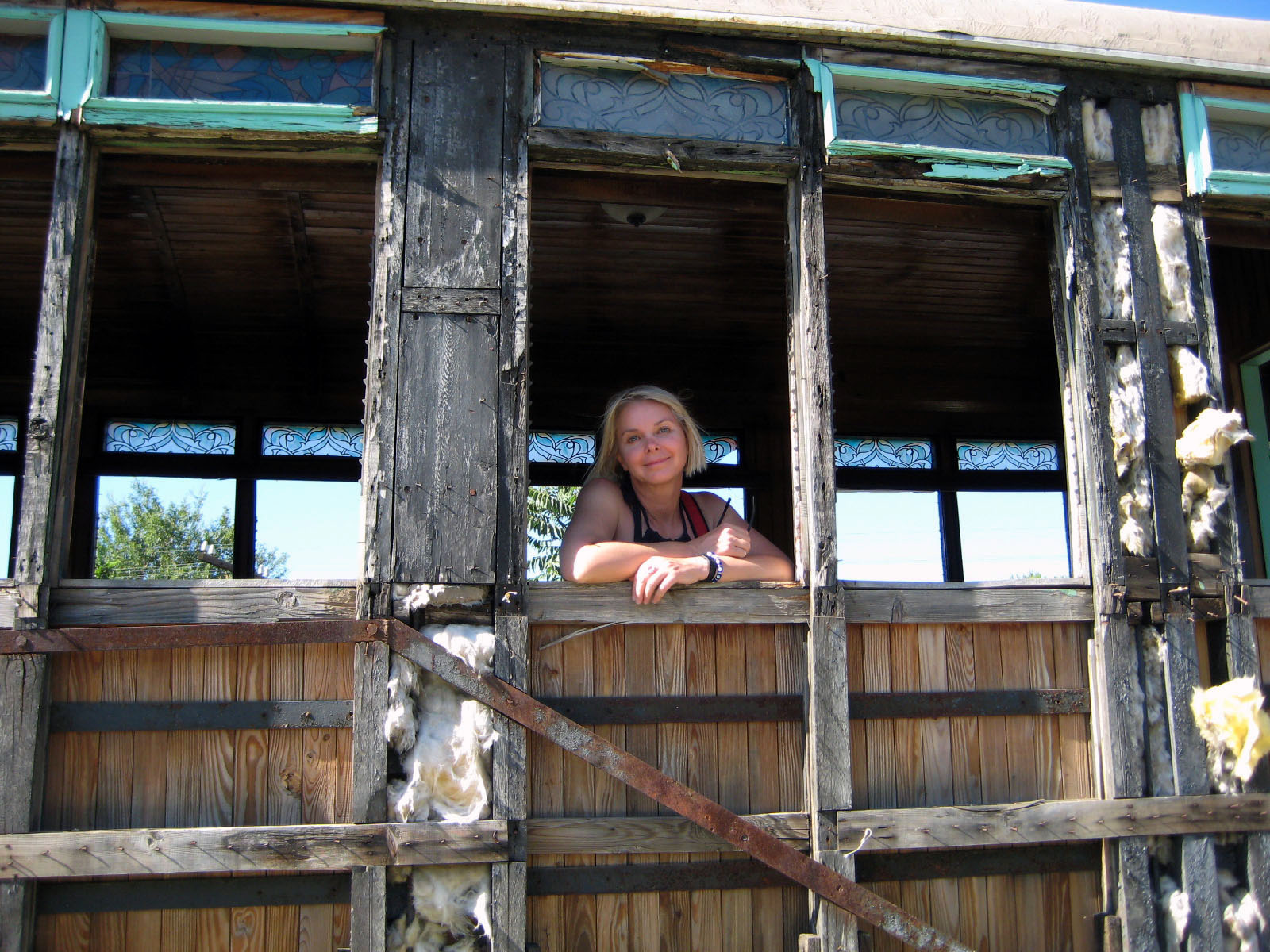 There were stream engines and rail cars going back to the early 1800s, all gently displayed along well-manicured lawns of green grass. Turkey had 3 inches of rain last year the entire region is parched and dry. A wayward match could devastate the area. But inside the train garden, it was lush and green. The prize of the collection was Attaturk’s person rail car, complete with a very substantial marble bath. He used this car as he traveled through the country, modernizing the people with a new alphabet, new rights of the people and new fashions.
There were stream engines and rail cars going back to the early 1800s, all gently displayed along well-manicured lawns of green grass. Turkey had 3 inches of rain last year the entire region is parched and dry. A wayward match could devastate the area. But inside the train garden, it was lush and green. The prize of the collection was Attaturk’s person rail car, complete with a very substantial marble bath. He used this car as he traveled through the country, modernizing the people with a new alphabet, new rights of the people and new fashions.
When we got back to the Muses, Stephen informed us that we’d be lucky enough to see a real Turkish wedding party that night in the village square. The villagers worked all day preparing gruel made of smashed lamb, flour and spices; smashing it up in a large (maybe 15 gallon) pot with boat oars.
As sunset came, so did the festivities. About 60 plastic chairs were set in the square in front of a makeshift stage where the band set up. When we wandered over, the bride and groom were just making their first appearance. She was still in her wedding dress and she was beautiful. Within minutes of their arrival, everyone hit the dance floor; small children in their party clothes, young boys with their heads buried into the firm breasts of young women, Nene (grandmothers) in headscarves and locals just having a good time. When the call to prayer assaulted the square from the nearby minaret’s loudspeakers, the music and dancing paused. But once the call ended (and oh they can go on for five minutes and longer), the party continued as if they were put on video pause.
It was fun for a while, but were we unprepared for a Turkish wedding. These things go on all night, sometimes for 2 or three nights. At 1:00am, the band had cranked up the volume and the entire village was whopping it up. By 3:00am, the amplifiers were turned up to eleven. Our room was a mere 100 meters from the square. Even with the double paned windows, there was no escape from the Turkish Kings of Pop. By 5:00am, the Imam opened the phone lines for the call to prayer. In modern Islam, the Imam no longer climbs up the minarets 5 times a day. Now he sits in a room somewhere nearby and makes radio addresses. Yes, the calls to prayer are “phoned in”.
Needless to say, we didn’t get much sleep. But that didn’t stop us. After a good breakfast of local cheeses, fresh tomatoes, cucumbers, bread and jam and good, strong Turkish coffee, we were off for a 3 hour drive up into the hills and onto the ancient city of Aphrodisias.
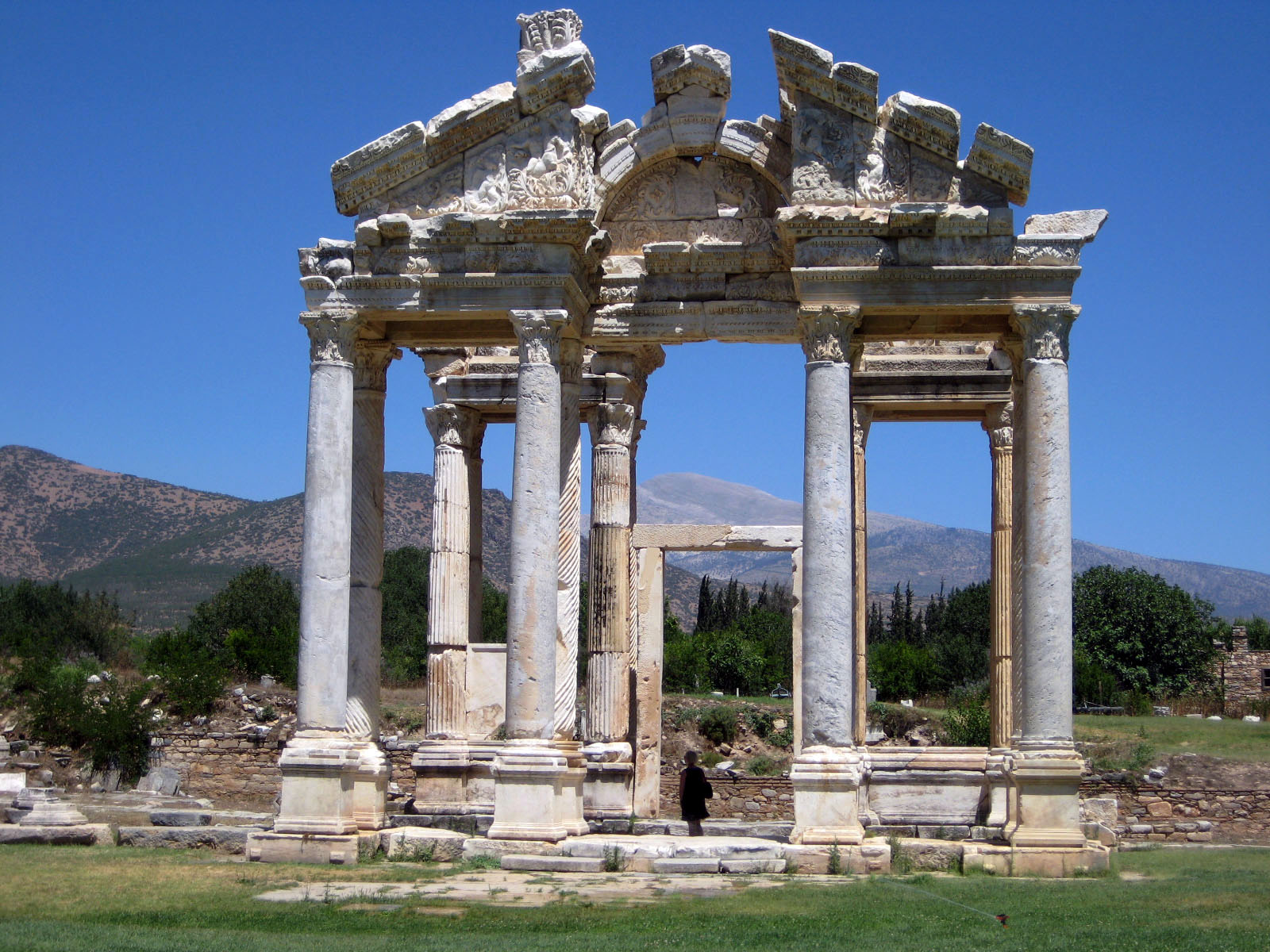 Aphrodisias was another cult community worshipping Aphrodite and the Caesars. In the late 1st century AD, it was under the personal protection of the Roman emperor Augustus. It was a prosperous city of about 15,000 people, a mixture of pagan cults and a very substantial Jewish community.
Aphrodisias was another cult community worshipping Aphrodite and the Caesars. In the late 1st century AD, it was under the personal protection of the Roman emperor Augustus. It was a prosperous city of about 15,000 people, a mixture of pagan cults and a very substantial Jewish community.
Aphrodisias never fully recovered from a 7th century earthquake. It fell into bad times and although people lived here for a few hundred years more, by the fourteenth century, they called it quits and moved on. In 1961, an archaeological excavation sponsored by New York University and National Geographic began reassembling the old city. It’s an ongoing project and excavation pavilions are set up throughout the city. They’re doing a good job. But the best part about Aphrodisias is that none of the cruise ship tourists from Kusadasi make it up here. Counting us, there might have been 10 people in the entire ancient city. It was so peaceful.
After fond farewells to Stephen, Adrian and Gokan (pronounced Gherkin, like the pickle) we once again poured a stream of water on the back of the rental car and headed south to the harbor town of Bodrum.
 Bodrum was once ancient Halicarnassus of Caria, and home to the Mausoleum of Maussollos, the other ancient wonders of the world in the area. In case you haven’t figured it out yet, the word mausoleum originates with the name of Maussollos.
Bodrum was once ancient Halicarnassus of Caria, and home to the Mausoleum of Maussollos, the other ancient wonders of the world in the area. In case you haven’t figured it out yet, the word mausoleum originates with the name of Maussollos.
Historically speaking, there was nothing very exciting about King Maussollos except the construction of his tomb. He wasn’t responsible for that either. The project (around 350 BC) was conceived and executed by his wife and sister Artemisia, who mourned the death of her husband/brother so deeply, she is said to have mixed his ashes in her daily drink.
She died within two years of his death, probably from a broken heart. When completed, the mausoleum was 140’ tall capped with a 20’ tall chariot statue at the top. The exterior walls were covered with life-sized, freestanding statues of people and animals. It stood erect for 16 centuries, until an earthquake caused some damage to the roof and colonnade. In the early 15th century, the Knights of St John of Malta invaded the region and built the massive crusader castle that still stands in the harbor. In 1494, when faced by attack from Suleiman the Magnificent, the Grand Master of the Castle, Thomas Docwra, ordered the knights to fortify it with the remains of the Mausoleum.
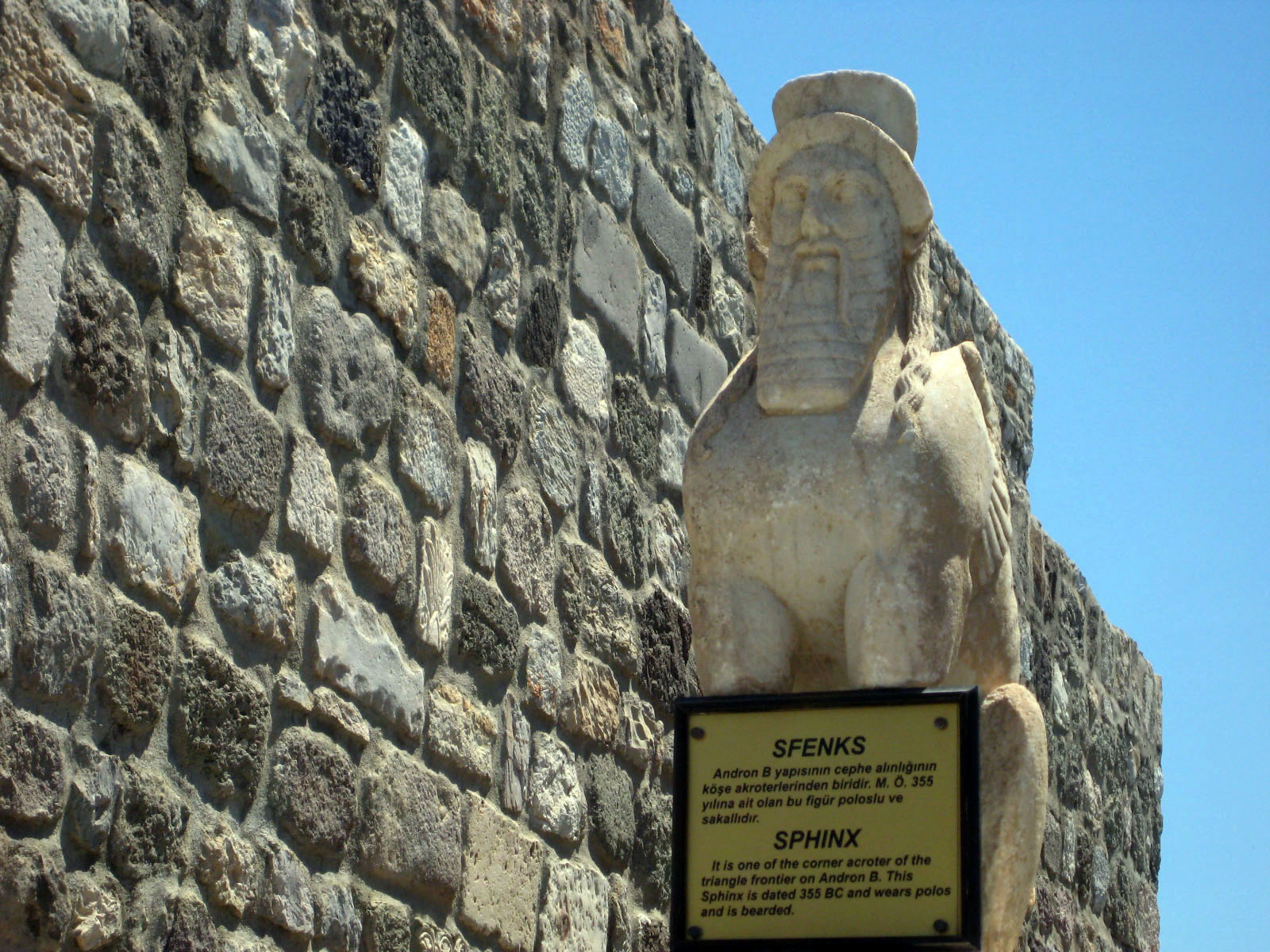 By 1522, almost every block of the Mausoleum had been removed and reused for the fortifications of the Castle. You can still see some of the polished stones and marbles blocks in the walls and there are a few of the statues in and around the fortress. You can also go to the British Museum to see some statues taken from the old site.
By 1522, almost every block of the Mausoleum had been removed and reused for the fortifications of the Castle. You can still see some of the polished stones and marbles blocks in the walls and there are a few of the statues in and around the fortress. You can also go to the British Museum to see some statues taken from the old site.
In 1523, one year after the Knights of St John finished dismantling one of the most incredible architectural achievements of the ancient world, they surrendered the fortress over to Suleiman the Magnificent, along with the other Crusader Castles of Rhodes and Kos. If Rhodes hadn’t fallen, the Hallicarnassus fortress might have held off Suleiman. There were 7 gates of defense and 5 towers manned by English, French, German, Italian and Spanish troops.
In 1895 the fortress was turned into a prison and held about 700 prisoners. In 1915, during World War I, the French bombed the hell out of it. The Turks rebuilt it but the reconstruction is very obvious.
Nonetheless, it’s a great historical park, filled with local craftsmen, spectacular views of the Aegean and a very interesting underwater museum, which is not underwater, showing ampoules, glass, pottery, anchors, tools, etc discovered in underwater salvage missions.
The only tower open to us was the English tower, which did have artifacts but the real interest was in the graffiti of the bored crusaders carving their names into the soft stone.
Hallicarnassus also gave the world Herodotus, the world’s first historian. His 9 volumes “The Histories (431-425 BC), a chronicle of the Greek-Persian War are still a best seller almost 2500 years later.
Herodotus is known as the originator of some great old expressions like:
“It is better to be envied than pitied” or “Haste in every business brings failures” (haste makes waste), or his most famous: “Not snow, nor rain, nor heat, nor night keeps them from accomplishing their appointed courses with all speed.”The US Post Office altered this one a little but nonetheless, it’s pure Herodotus.
 Today Hallicarnassus or Bodrum is the home to Turkish movie and music stars. It’s beautiful location; posh resorts and turquoise waters have made it an international destination. The harbor is filled with enormous sailboats, yachts, gullets and cruise ships. The harbor town is a spider web of small winding streets packed with jewelry, hand made sandals, clothing, suntan lotions, tobacco shops, grocery stores, restaurants, cafes and bars. At night, the town turns into one big disco party. That must really piss off the Muslim fundamentalists.
Today Hallicarnassus or Bodrum is the home to Turkish movie and music stars. It’s beautiful location; posh resorts and turquoise waters have made it an international destination. The harbor is filled with enormous sailboats, yachts, gullets and cruise ships. The harbor town is a spider web of small winding streets packed with jewelry, hand made sandals, clothing, suntan lotions, tobacco shops, grocery stores, restaurants, cafes and bars. At night, the town turns into one big disco party. That must really piss off the Muslim fundamentalists.
But lucky us, we’re staying up on the hill overlooking the city. We can barely hear the Imam’s call to prayer or the disco clubs. All we hear is the hum of the air conditioning lulling us to sleep.
This area of the Aegean is also famous for a whacky sport where a female camel in heat is put in front of two males and they fight it out. A camel can win by making the other camel scream, fall or run away. Before the grand match, the colorfully decorated camels march through town in a big Parade. From what I’ve read, the camels get very excited during the fights and spectators are known to be assaulted with flying saliva and flying urine. Sounds like good ol’ Turkish fun. Maybe I’m glad we missed it.
You must be logged in to post a comment.